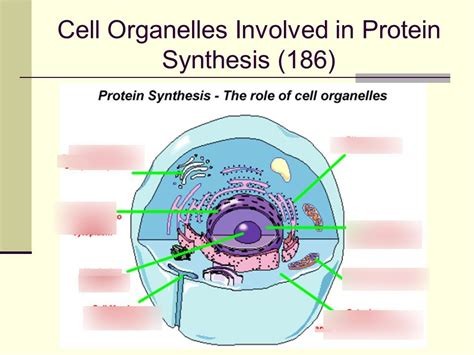The ribosome is the organelle responsible for protein synthesis in cells. Ribosomes are complex structures composed of RNA and proteins and are found in both prokaryotic and eukaryotic cells. In prokaryotes, ribosomes are found free in the cytoplasm, while in eukaryotes, they are located in the cytoplasm and attached to the rough endoplasmic reticulum (RER).

Structure of Ribosomes
Ribosomes are composed of two subunits, a large subunit and a small subunit. The large subunit contains the peptidyl transferase enzyme, which is responsible for catalyzing the formation of peptide bonds between amino acids. The small subunit contains the decoding center, which is responsible for binding to messenger RNA (mRNA) and ensuring that the correct amino acids are added to the growing polypeptide chain.
Protein Synthesis Process
Protein synthesis is a complex process that involves several steps:
- Transcription: DNA is transcribed into mRNA in the nucleus.
- Translation: mRNA is transported to the cytoplasm and binds to a ribosome.
- Initiation: A small subunit of the ribosome binds to mRNA, and a tRNA molecule carrying the starting amino acid (usually methionine) binds to the start codon (AUG).
- Elongation: The ribosome moves along the mRNA, and tRNA molecules carrying the next amino acids bind to the growing polypeptide chain.
- Termination: When a stop codon (UAA, UAG, or UGA) is encountered on the mRNA, translation is terminated, and the newly synthesized protein is released.
Ribosomes in Prokaryotes and Eukaryotes
The ribosomes of prokaryotes are smaller (70S) than those of eukaryotes (80S). Prokaryotic ribosomes consist of a 30S small subunit and a 50S large subunit, while eukaryotic ribosomes consist of a 40S small subunit and a 60S large subunit.
Ribosomes and Disease
Ribosomes are essential for the survival of cells, and defects in ribosome function can lead to a variety of diseases. For example, mutations in ribosomal proteins have been linked to several types of cancer and neurodegenerative diseases.
New Applications of Ribosomes
The discovery of ribosomes has led to a number of new applications, including:
- Ribosome profiling: This technique allows researchers to study the translation of mRNA in cells and identify the proteins that are being synthesized.
- Ribosome engineering: This technology allows researchers to modify ribosomes to produce new proteins or to inhibit the translation of specific proteins.
- Ribosome-based antibiotics: Antibiotics that target ribosomes are used to treat a variety of bacterial infections.
Table 1: Comparison of Prokaryotic and Eukaryotic Ribosomes
| Feature | Prokaryotic Ribosomes | Eukaryotic Ribosomes |
|---|---|---|
| Size | 70S | 80S |
| Subunits | 30S small subunit, 50S large subunit | 40S small subunit, 60S large subunit |
| Location | Cytoplasm | Cytoplasm and RER |
Table 2: Steps of Protein Synthesis
| Step | Description |
|---|---|
| Transcription | DNA is transcribed into mRNA in the nucleus. |
| Translation | mRNA is transported to the cytoplasm and binds to a ribosome. |
| Initiation | A small subunit of the ribosome binds to mRNA, and a tRNA molecule carrying the starting amino acid binds to the start codon (AUG). |
| Elongation | The ribosome moves along the mRNA, and tRNA molecules carrying the next amino acids bind to the growing polypeptide chain. |
| Termination | When a stop codon (UAA, UAG, or UGA) is encountered on the mRNA, translation is terminated, and the newly synthesized protein is released. |
Table 3: Diseases Associated with Ribosome Defects
| Disease | Cause |
|---|---|
| Cancer | Mutations in ribosomal proteins |
| Neurodegenerative diseases | Mutations in ribosomal proteins |
| Diamond-Blackfan anemia | Mutations in ribosomal proteins |
Table 4: Applications of Ribosomes
| Application | Description |
|---|---|
| Ribosome profiling | Allows researchers to study the translation of mRNA in cells and identify the proteins that are being synthesized. |
| Ribosome engineering | Allows researchers to modify ribosomes to produce new proteins or to inhibit the translation of specific proteins. |
| Ribosome-based antibiotics | Antibiotics that target ribosomes are used to treat a variety of bacterial infections. |
Tips and Tricks for Ribosome Research
- Use high-quality reagents. Ribosome research is sensitive to the quality of the reagents used. Make sure to use high-quality reagents from reputable suppliers.
- Control for experimental conditions. Ribosome research is also sensitive to experimental conditions. Make sure to control for all experimental conditions, including temperature, pH, and ionic strength.
- Replicate your experiments. Always replicate your experiments to ensure that your results are reproducible.
- Collaborate with other researchers. Ribosome research is a complex field. Collaborating with other researchers can help you to overcome challenges and achieve your research goals.
Conclusion
Ribosomes are essential organelles responsible for protein synthesis in cells. The discovery of ribosomes has led to a number of new applications, including ribosome profiling, ribosome engineering, and ribosome-based antibiotics. Continued research on ribosomes will further expand our understanding of these essential organelles and their role in human health and disease.
